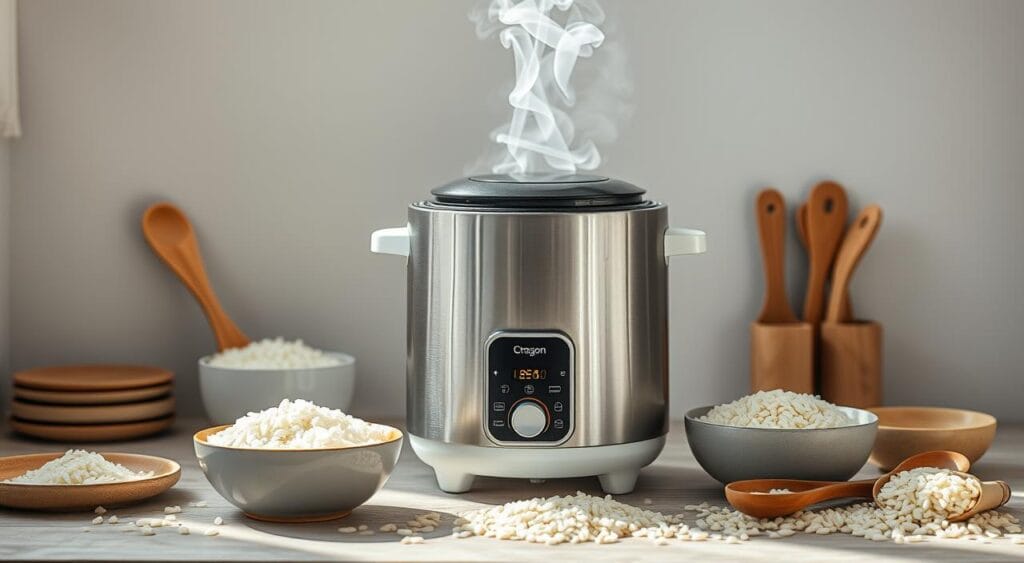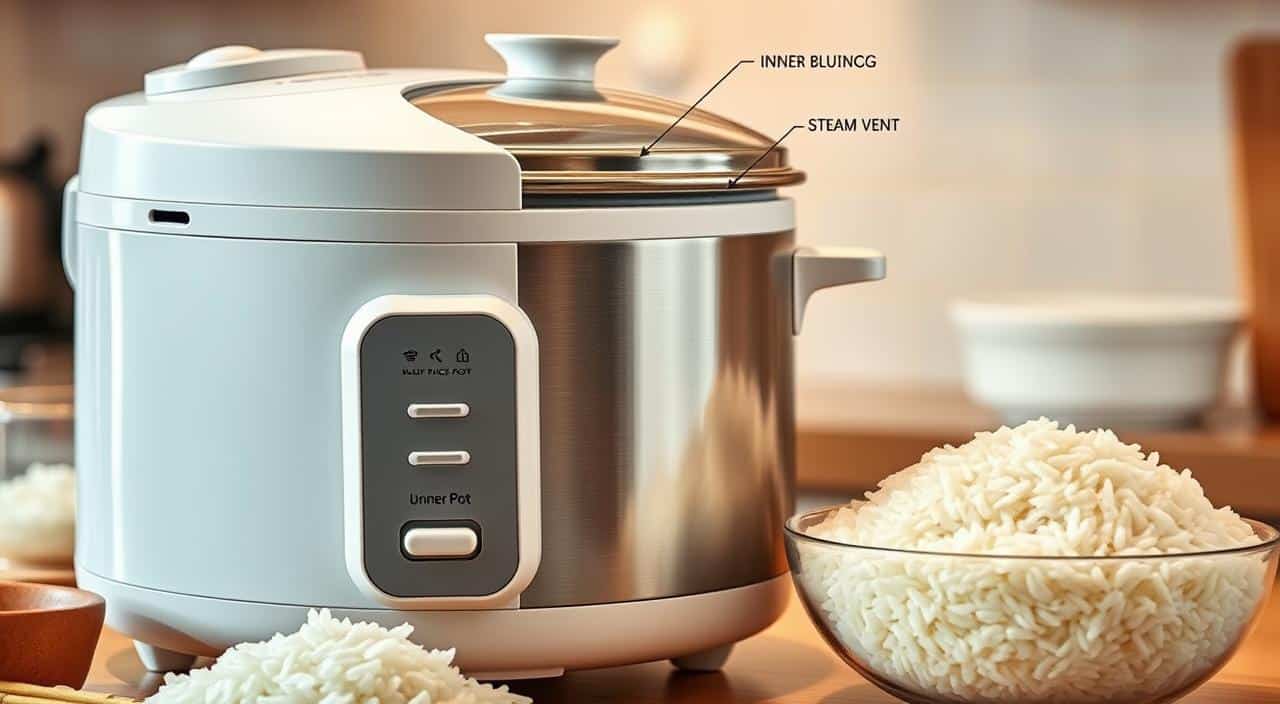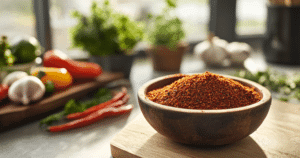Jump to:
Estimated reading time: 11 minutes
Table of contents
What is a basic rice cooker? A basic rice cooker is a must-have in your kitchen. It makes cooking rice easy and automatic. This guide will show you how to get perfect rice every time.
It uses the right water-to-rice ratio and has an automatic shut-off. This means you don’t have to worry about cooking rice the old way. Brands like Aroma and Zojirushi have many models to fit your needs.
Key Takeaways
- A basic rice cooker automates rice cooking, ensuring consistent results.
- These cookers typically offer two primary settings: ‘cook’ and ‘warm’.
- Popular brands include Aroma and Zojirushi, featuring diverse models.
- They are budget-friendly, with standard models priced between $15 and $50.
- Cleaning is straightforward, requiring just a damp cloth and occasional maintenance.
- A basic rice cooker can serve families of 4 with ease, cooking up to 10 cups of rice.
- For more detailed information, check out this guide on rice cookers.
Introduction
Rice cookers have changed how we cook at home, becoming key for rice lovers. They make cooking easier and ensure rice is always perfect. As more families add rice to their meals, the appeal of a beginner rice cooker grows.
This simple cooking guide will cover the basics of rice cookers. We’ll look at their benefits and how they make cooking simpler.

This article will show why a basic rice cooker is so useful. Its automatic cooking and keep-warm features make it a great addition to any kitchen. It’s a smart choice for anyone wanting to improve their cooking skills.
What Makes a Rice Cooker “Basic”?
Understanding what makes it basic is key. These appliances make cooking rice easy, perfect for those who like simple tech. They have standard rice cooker functions that focus on ease and reliability.
Simple Functions and Controls
Basic rice cookers are simple, with just an on/off switch and two settings: ‘cook’ and ‘warm.’ This is different from advanced models with many rice cooker features. Their simplicity means less chance of mistakes, leading to perfect rice every time.
Cooking Capacity and Size
Basic rice cookers vary in size to fit different needs. They range from 500ml for small families to 4.6 liters for big groups. This ensures there’s a model for everyone. For example, the Black & Decker RC3303 is around $22, but can be as low as $12 on Amazon.
Basic vs. Advanced Rice Cookers
Knowing the difference between basic and advanced rice cookers helps in choosing. Basic models focus on the basics, while advanced ones have more features. For simple cooking, a basic rice cooker like the Hamilton Beach Digital Simplicity at $50 is great. For luxury, there’s the Zojirushi Induction Heating Pressure Rice Cooker for about $500.

Basic rice cookers are made for everyday use, focusing on ease and efficiency. A detailed article on what is a basic rice cooker shows they can keep rice warm for 12 hours. This makes choosing the right rice cooker easy.
Key Basic Rice Cooker Features
Understanding the basic rice cooker features can make cooking easier. These units are simple and efficient. They are great for those who want a hassle-free cooking experience.
On/Off Switch and Automatic Shutoff
A basic rice cooker has a simple on/off switch. This makes it easy to use without getting confused. The automatic shutoff turns off the cooker when the rice is done. This prevents overcooking and ensures fluffy rice every time.
Keep-Warm Function for Convenience
The keep-warm function is a great feature. It keeps the rice at the perfect temperature. This means you can prepare meals ahead of time, knowing the rice will stay warm and ready to eat.
Nonstick Inner Pot for Easy Cleaning
A nonstick inner pot makes cleaning easy. It prevents rice from sticking, making cleanup simple. Most basic rice cookers come with this feature, making them easy to use.

| Feature | Cuckoo Rice Cooker | Aroma Rice Cooker | KitchenAid Rice Cooker |
|---|---|---|---|
| Capacity (cups uncooked) | 10 | 4 | 4.25 |
| Power (watts) | 1150 | 450 | 750 |
| Time to Cook White Rice (minutes) | 25 | 25 | 30 |
| Dimensions (inches) | 14.2 x 11.6 x 10.2 | 8.6 x 8.5 x 9.3 | 9.75 x 13.5 x 8.88 |
| Weight (pounds) | 16 | 4.9 | 10.5 |
For more cooking tips, check out a guide on barbecue seasoning. It can help improve your grilling.
How Does a Basic Rice Cooker Work?
Learning how a rice cooker works is key to making perfect rice. This appliance makes cooking rice easy by controlling water, heat, and timing. It ensures your rice turns out great every time.
The Water-to-Rice Ratio and Heating Element
A good rice cooker uses the right water-to-rice ratio. It’s usually 2:1, or two cups of water for one cup of rice. Water is important for heat transfer, helping the mixture boil at 100°C (212°F) at sea level.
The heating element quickly heats the water. This causes it to boil, starting the cooking process.
Steam Pressure and Rice Cooking Process
Steam is crucial in cooking rice. As rice absorbs moisture, steam builds up. This cooks the rice evenly.
Advanced rice cookers adjust cooking times and temperatures. They use fuzzy logic for different types of rice. Rinsing rice before cooking can also help, removing excess starch.
How the Cooker Knows When the Rice is Done
Knowing when rice is cooked is important for quality. Older models used a bimetallic switch to detect high temperatures. Modern ones use thermostats or magnetic sensors for better control.
When water evaporates and temperature rises, the cooker switches to ‘keep warm’ mode. This lets the rice rest, improving flavor and texture. This quick method also saves time, allowing you to do other things while the rice cooks.
Types of Rice Cookers: Basic vs. Digital and Multi-Function
Knowing the different types of rice cookers can make cooking better. You might choose between basic and advanced models based on what you need. Each type has special features for different cooking tasks.
Standard Basic Cookers: Affordable and Efficient
Basic rice cookers are great for those who want something simple and affordable. They’re easy to use and perfect for cooking rice. They usually have a simple switch and a keep-warm function.
These cookers are ideal for those who mainly cook rice. They show a clear difference between basic and advanced models.
Digital and Multi-Cook Options: Extra Features and Flexibility
Digital rice cookers offer more features for cooking flexibility. They let you set different cooking options for different grains. They also have a delay timer and multiple cooking modes.
Models from Aroma, for example, can cook quinoa and steam vegetables. This makes them great for those who want to cook more than just rice.
When to Choose a Basic Rice Cooker Over an Advanced Model
If you prefer simplicity, a basic rice cooker is a good choice. They are perfect for small kitchens or if you only need to cook rice. Advanced models offer more flexibility for various cooking needs.
Think about your cooking habits and space when deciding. For businesses, Culinary Depot can help find the right model.
Benefits of Using a Basic Rice Cooker
A basic rice cooker offers many advantages. It’s perfect for both new cooks and experienced chefs. It makes cooking easier and fits various needs, enhancing your kitchen experience.
Time-Saving and Easy to Use
Rice cookers are simple and efficient. With just a button press, you can cook perfect rice without constant watching. This saves time and lets you focus on other parts of your meal, great for busy kitchens.
Ideal for Beginners and Small Kitchens
Rice cookers are great for beginners. They’re easy to use, unlike traditional cooking methods. Their compact size fits well in small kitchens, ideal for city living or limited space.
Budget-Friendly Cooking Appliance
Affordable rice cookers are easy to find. Basic models cost under $50, offering great value. They provide reliable and tasty meals without spending a lot.
| Benefit | Description |
|---|---|
| Time-Saving | Prepares rice automatically, freeing time for other cooking tasks. |
| User-Friendly | Ideal for beginners owing to its simple controls and functions. |
| Compact Size | Fits well in small kitchens, making it suitable for limited spaces. |
| Affordable | Basic models available under $50, offering great value for money. |
| Energy-Efficient | Uses less energy than traditional cooking methods, promoting sustainability. |
Common Issues with Basic Rice Cookers and How to Solve Them
Many users face problems with their rice cookers. These issues can affect how well the cooker works. Knowing how to fix these problems can make cooking rice easier and better.
Overcooking or Undercooking Rice
One big problem is overcooking or undercooking rice. Most of the time, it’s because of the wrong water-to-rice ratio. It’s important to follow the right water levels for each type of rice. For example, long-grain rice needs less water than short-grain rice.
Always check the manufacturer’s guidelines for the best results. This way, you can get the perfect texture every time.
Cleaning and Maintaining the Nonstick Pot
Keeping the rice cooker pot clean is key for good performance. Not cleaning it well can cause problems. About 40% of issues come from not cleaning it enough or from water getting into the contacts and magnet.
Use gentle cleaners and avoid harsh scrubs. This helps keep the nonstick surface in good shape. Taking care of your cooker makes it last longer and cook better.
Preventing Sticking and Burning in Basic Models
To stop rice from sticking and burning, prepare it carefully. Rinsing the rice well helps reduce starch buildup. This makes it less likely to stick.
Also, make sure to measure the water right. Too much water can cause sticking and even damage the heating plate. Following the right cooking tips helps avoid these problems and makes cooking more efficient.
FAQ: What is a basic rice cooker?
What is a basic rice cooker?
A basic rice cooker is a kitchen appliance designed to cook rice easily by using a straightforward heating mechanism. It typically has a simple one-touch operation with an “on/off” or “cook/warm” button and automatically switches to “warm” mode once the rice is fully cooked. Basic rice cookers are affordable, easy to use, and efficient for cooking various types of rice.
How does a basic rice cooker work?
A basic rice cooker heats a pot of rice and water until it reaches a specific temperature, which causes the water to steam and absorb into the rice. When all the water has been absorbed, the cooker detects the temperature change and automatically switches to “keep warm” mode to prevent overcooking.
What types of rice can you cook in a basic rice cooker?
A basic rice cooker can cook most common types of rice, including white rice, brown rice, basmati, and jasmine rice. For harder-to-cook grains like brown rice, it may require a bit of extra water and cooking time. Some advanced models are better suited for specialty grains.
Can a basic rice cooker cook other foods?
Yes, while limited, a basic rice cooker can cook simple dishes beyond rice, like quinoa, oatmeal, or steamed vegetables if it includes a steaming basket. However, it may not have enough settings for more complex dishes, which are better suited for advanced multi-cookers.
Conclusion: Understanding the Simplicity and Efficiency of Basic Rice Cookers
Basic rice cookers are more than just kitchen tools. They bring many basic rice cooker advantages to our cooking. They make it easy to cook fluffy, perfect rice without watching it all the time. Models like the Gaabor GR-S50D, with its 5L capacity, are great for big families.
Using a rice cooker saves time. It lets you do other things while your rice cooks. White rice cooks in 20 to 30 minutes, and brown rice takes up to 50 minutes. This way, you always get great results. The cooking simplicity doesn’t stop there. Many models can cook different dishes, making them very versatile.
Getting a basic rice cooker can really make cooking easier. It’s energy-efficient and has safety features. It makes cooking more fun and efficient. Understanding its benefits is key for anyone wanting to improve their cooking skills.






